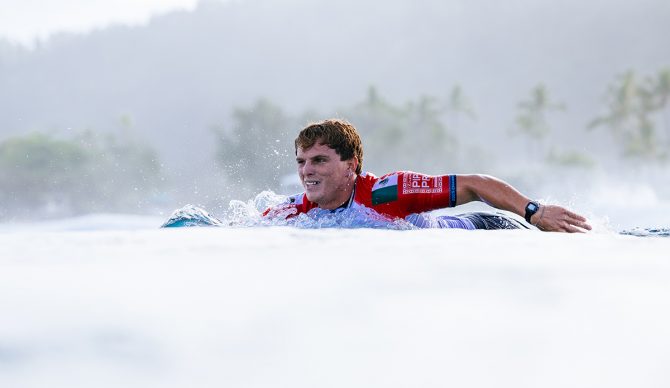
Cleland put the work in. Photo: Brent Bielmann//World Surf League
For the first time ever, a Mexican surfer is competing on the WSL Championship Tour. Alan Cleland’s qualification isn’t just a personal milestone. It’s a potentially pivotal moment for a nation – a country with a deep, storied surf culture historically underrepresented at the professional level.
Once you sift past the eye-catching headlines of Cleland’s arrival to the tour, his achievement raises questions: In a nation with world-class waves that has long been a favorite destination for traveling surfers, why did it take this long for a Mexican to break through? And more importantly, is Cleland’s success the trickle of water that opens the floodgates for more to follow, or is it a story of an isolated talent?
As the 22-year-old Pascuales local commences his rookie season, those who came before him and those who aspire to come after are watching closely, hoping his rise can spark something bigger.
More than two decades ago, when Kalle Carranza was Mexico’s national champion and gracing the cover of SURFER magazine, qualifying for the CT wasn’t just difficult – it felt impossible. No one before him had done it; there was no concrete path to connect the dots from a small Mexican village to the pro tour.
“You don’t really understand what’s possible until someone near you does it,” said the 44-year-old Carranza, a resident of Sayulita, Nayarit. “Now you see someone from (Mexico qualify), and kids will be like, ‘If Alan did it, I can too.’”
When Carranza heard the news of Cleland’s qualification, he sent him a strong but simple message: “Head down and win events. Do it for everyone and everything you’ve gone through. Don’t veer off the tracks. Party when the year is over. Work now. You got this.”
Throughout Carranza’s decades surfing in Mexico, he’s seen other promising talents emerge, but few ever reached their full potential. Mexican surfers face undeniable obstacles, like obtaining financial resources and visas to compete abroad. Cleland is fortunate to have dual nationality between Mexico and the U.S., but Carranza says the real barrier he overcame was mental.
“Quite a few surfers could have (succeeded) just based on talent,” said Carranza. “But it’s the mental aspect. This is a one-in-a-million kid that just happened to put his head down.”
By Carranza’s assessment, there isn’t a squad of hungry, young Mexican surfers ready to build on Cleland’s feat. There is no ‘Mexican storm’ about to take over like the Brazilians did (with similar financial and visa constraints) in the previous decade.
“None of the kids that I know around here are actually working hard to become better at surfing, working on their weaknesses,” said Carranza. “There’s not enough discipline for guys to want to do that. It’s too easy to just be the little ripper in town and not go chase it.”
“But people need to understand that there’s no help,” he added. “The government isn’t doing anything to help these surfers. And there are almost no competitions motivating kids to surf more.”
Another former Mexican champion, Roberto Salinas, agrees. “(Mexican surfing) has developed pretty slowly,” said Salinas, a 54-year-old Puerto Escondido local and seven-time national champion. “For things to change, they would have to do more contests in Mexico and focus on the kids with talent. Mexico has always had good surfers.”
In 2024, Mexico had just two QS 1000 events in Puerto Escondido and Cerritos. Several of the regional surfing associations run a handful of local events, but, as Salinas and Carranza lamented, there isn’t a ton of opportunity to hone one’s competitive skills without going abroad.
Despite the lack of contests, many believe Cleland’s success could still be a turning point. Renowned Puerto Escondido surf photographer Edwin Morales is optimistic that it will bear fruit.
“Qualifying for the tour 10 years ago seemed impossible,” said Morales. “I’m confident that more Mexican surfers will qualify 10 years from now thanks to the path that Alan is opening. If it weren’t for him, things would be different.”
As of now, there are no Mexican men or women ranked on the WSL Challenger Series, which feeds into the Championship Tour. But as far as who could be next, Carranza points to the 24-year-old Puerto Escondido local Sebastian Williams as a young talent who is more than capable.
“I’m happy to see Alan achieve his dream,” Williams said when asked if Cleland’s achievement could nudge him towards the tour. “It gives me a lot of motivation to also get to that competitive level.”
Whether Cleland’s success will lead to a new wave of Mexican talent remains to be seen, but he has already rewritten what’s possible. His message to young surfers back home rang clear during his post-heat interview at Pipeline: “You can come from the smallest town in the world, do the hard work and make it happen. More than anything, (I’m) trying to represent my flag and where I’m from: Pascuales.”
The question now isn’t whether a Mexican surfer can make it, but whether other surfers can muster the support and grit needed to follow Cleland’s lead.

